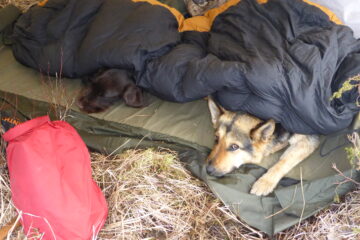Every dog is different and everything needs to be adjusted to the individual!
The human managed to get the trust of dogs and started interacting with them. But how to interact? When I tell the dog “Go into your corner and lay down” he doesn’t understand the words. Dogs don’t speak and they can’t understand language. But they are very good in learning, that specific triggers lead to specific happenings. So what kind of triggers can we give to communicate?
It is worth to remember: Dogs can’t change their behavior to human behavior. But humans can change their behavior to dog behavior.
To communicate and interact with a dog you need to behave more like another dog then a human.
Of course they also learn from you what unknown behavior can mean. But keeping it closer to dog behavior makes interaction better. We see that with cats and dogs very well. In the cat world a lot of signs mean the opposite from what it means in the dog world. Therefor they never really get very close and most times their relation only works partly if they grow up together.


senses
A dog has the same senses like a human, plus magnetism. Of course the quality of them is very different. He can smell, see, hear, feel and taste. Besides that dogs have very good social capabilities which is discussed in the section “own feelings”.
smell
The smell is compared to the human excellent, there is no question about that. In all ways dogs smell much much better. But this sense is also limited to physics. In the last years, especially in man trailing from police k9 units, the expectations got unrealistic. A dog can only smell what is still there. Normally already after 24 hours of outside climate exposition it can be challenging for a dog to smell weaker traces.
An easy to understand and interesting paper is the following: https://www.ncbi.nlm.nih.gov/pmc/articles/PMC10570582/
tip: If you look for scientific papers you often find them on the highly prices platforms. But if you search a little bit longer for the headline you often find them legally also somewhere else.
seeing
The dog sees different then a human. He can’t see the color red. But otherwise he sees about 240° (compared to 180° from the human) and because his eye is reflecting the light inside a second time he can see much better then the human when it is dark. He is just seeing in about 60° three dimensional because his eyes look more to the side and the field of view is overlapping less.
But from the evolution his brain developed to concentrate on movements. By that it is much harder for him to recognize still standing things then for the human.
hearing
The dog can hear a wider frequency range then the human. Especially high tones. But the latest science is a little bit unsure if he can hear better (louder). Some newer science states that the loudness he hears is about the same or slightly higher then the human.
Because his ears can move he is much much better in hearing from which direction a sound comes. Even over long distances they can locate a one-time noise extremely accurate.
feeling
Dogs have some very sensible body regions. But overall the dog has less nerves for feeling then the human. Evolution wise it wouldn’t make much sense to get so much input from the fur regions. Dogs are sensitive on the paws and the toes. They can feel movements on the floor. The nose and lips are a very sensitive area. Besides that the dog has a lot of nerves which feel the movement of the hair in the skin, especially in the face. The air movement of a just passing object is enough that the dog can feel it in the skin hair.
They feel pain similar to the human.
Overall they do not feel warmth (besides a few small exceptions). But they can feel cold. They react to heat often only when it is getting painful.
There is research if they can feel infrared radiation (heat) with their nose because the nose is inside pretty cold compared to other animals but has receptors for heat. I discovered that some dogs are more afraid of fire, for example, then others. This is often the case when the dog is overall more sensitive.
This sense is also very important because a lot of emotional interaction is happening by it. By understanding the feeling a human can learn to do the things the dog like.
taste
For the interaction the taste of the dog does not play a big role. It is similar to the human.
magnetism
The dog feels the earth magnetism. That is most likely one reason why he can go back to a point often in a straight line instead of following his track. That also helps him to have an outstanding orienteering. Fun fact: For Orienteering (the sports) you can train a dog to go a straight line. This is a huge advantage but dogs are normally allowed.
I also discovered dogs who do not seem to utilize it or are not able to.
how to talk dog language

If you want to give any kind of input to your dog you need to make sure that your dog notices it. That’s why the list of senses is important to have in mind. We can mainly use the senses hearing, seeing and feeling. Often we utilize several of them to be more flexible with giving commands, for example when you call your dog to you you also make a movement/sign. Even a dog can not see standing things very well he learns to realize the signs for important commands pretty well even if he did not saw the movement. For example for the calling here command I point up in the air. And even if the dog clearly faces away while raising the arm he often sees my raised arm pretty well and comes – without saying the command.
commands by voice
Dogs don’t understand any language, but they here sounds. Therefor it is good to think about the commands before using them. I start with an example:
In Finland a lot of people use
Tule tänne
Finnish for “come here”
It works, but it is not so easy to recognize for the dog. You do not have any high pitch vowels you can stretch to make the command clear and longer. It is better to make things always easy and clear. In the Finnish language there are also very good words as commands like “haku” which means search.
A good command covers the following aspects:
- clearly different from all the others
- more a sound then a word
- possibility to stretch the command if the dog is further away
- good for the human to pronounce
- different from spoken languages to prevent confusion
- pronounced hard
- not more then two syllables
- no soft consonants
- pronounce them that they sound more like a sound instead of a word
This points especially count for the dogs name! The name is the most important command as it initializes the attention of the dog. For important commands you should really think about the word.
simplifications
When you have 80 to 100 commands it can be hard to always come up with a new word which covers all the demands and remembering it well. Here you can use a trick: Use the words from a language, for example “gehe weg”, which means go away. This is too long and too soft, harder to understand for the dog. Now we just start leaving consonants and vowels away to shorten it to “g’weg”. It is still not perfect as you can’t say this command very loud and clear but it is a suitable sound for the short distances were you use the command.
For less important commands you can do this simplifications. The commands are easier to remember for you and they are more away from ordinary language. It also helps if you choose a foreign language you normally do not speak to keep the commands even more away from your daily language.
commands by sign
Signs are very important. Sometimes you do not want to say anything, for example in hunting, when you are talking to other people or the distance is high and the wind is bad so that the dog can’t hear you very well. You shouldn’t choose a sign for every command because it is hard to find so many clear distinguishable signs which can’t be misinterpreted.
The most important commands to have a sign for are “come here”, “get down” and “come with”. For example for “come here” I point up in the air and for “get down” I do the a movement like pushing the dog on the ground. Then for moving left or right it is of course very intuitive to point in the direction. They are totally different and therefor work reliable in the field.
It can help with other commands to also make specific movements, even if the movements alone do not serve as a command. For example for fetching something when the dog sits next to you a sudden forward movement with pointing in the direction can help a lot. Fast movements motivate the dog and the pointing can help that the dog is finding the thing to fetch.
Especially with the signs you need to think carefully what the dog can recognize good and clearly. You should not be too strict if the dog makes mistakes here. Often dogs are misinterpreting something and do not necessarily not obey.
commands by feeling
Also feeling is an important way of communicating. This is a very intuitive thing so it is hard to explain generally. I will give some examples:
- When you teach your dog to lay down you can give light pressure on the front part of the back that the dog gets the leading from you what to do.
- When your dog is starting to pull on the leash you shortly pull back that the dog clearly needs to change his movement.
- Closeness, which is very important, is shown by feeling to pet the dog on the points where he likes it, for example scratching on the back. The dog also shows in different way his closeness if the owner allows it (i.e. licking)
combination of inputs by situations
There are situations where you should give different inputs depending on the situation. For example your dog did something right it can be good to express your happiness with the reward command but also jump around to motivate the dog. In other situations were you use the reward command it can be used together with petting the dog and show him closeness. So sometimes you combine a spoken command with feeling or with signs.
own feelings
One thing dogs can understand very well and what we did not cover so far are your own feelings. Dogs can incredible well feel in which mood and condition the owner is. Their social understanding is very well. For example if you are angry because the dog did something wrong and you try to suppress it, dogs still can feel that often very well. It can be a huge problem, for example preventing the dog coming back to you.
Often dogs are misinterpreted. When a dog comes back with the head down owners often think the dog understood, that he did something wrong. That is in most cases not true. The body language and the feelings of the owner tell the dog that the owner is upset. That is why they lower the head and try to be careful and nice. Dogs are often misunderstood because the human makes wrong connections.
During dog training it is extremely important to review own feelings and own body language. It can have a very negative impact, especially with young dogs, if the dog makes wrong connections here. You should always stop training when your own feelings start to arise.
Sometimes you need to fake your feelings and behaving according to the situation. While very few humans get enthusiastic running after a thrown thing dogs do. For example to motivate your dog it is good to play enthusiastic in some situations.
verdict
Dogs can not understand voice. But they are very sensitive for different kinds of input. It is always worth remembering what the dog can recognize good and what he can clearly separate from other inputs.
Remember the following:
- Dogs do not understand human behavior, but they understand dog behavior. Behave more like another dog.
- Commands should not sound like ordinary language.
- Commands should be easy recognizable for the dog by their sounding, not by words.
- Keep the capabilities of your dog in mind. When a dog is chasing something 300m away it doesn’t help shouting after it.
- Control your own feelings, especially when interacting with a dog. Dogs sense your feelings and body language very well.


